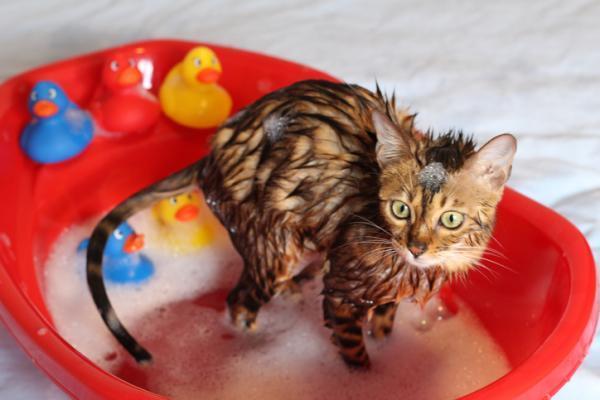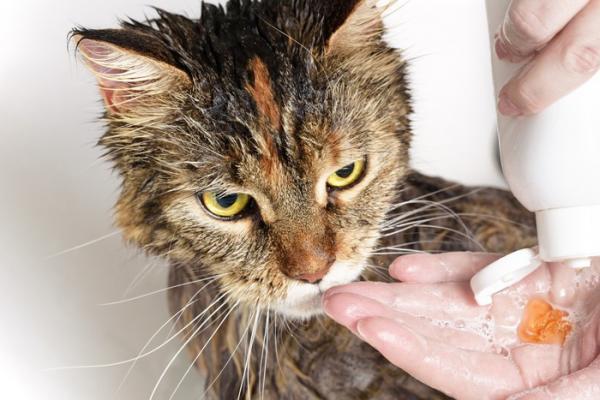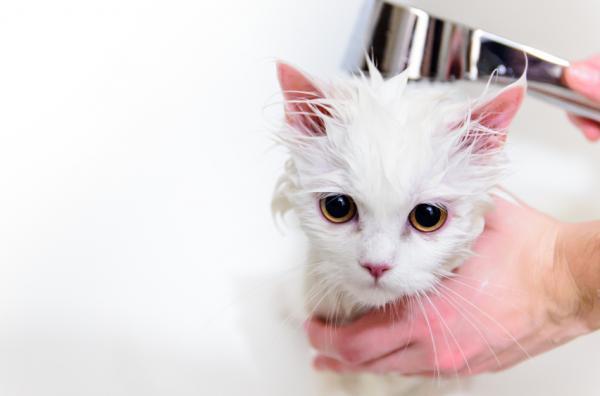
Cats are very hygienic animals. If they do not spend a large part of their waking life licking and grooming themselves, then it means there is something wrong. For this reason, there are not many occasions where you will need to bathe the cat. In general, the less we bathe them the better.
However, there are reasons why periodic bathing of a cat may be useful. This will depend on various factors, but the underlying issue is maintaining the cat's health and well-being. At AnimalWised, we ask how often should I bathe my cat?
Is it necessary to bathe cats?
A cat's grooming behavior is multi-functional. The time they dedicate to maintaining their fur is not for aesthetic reasons. Cats groom themselves and groom each other as a way to remove dirt, bacteria and even parasites which can adhere themselves to their fur. They do so, in part, with a tongue covered in papillae. These are keratinized spines which act like an organic comb.
Cats only abandon their strict grooming schedule when they are unwell. For this reason, a healthy cat which lives indoors is unlikely to require their guardian to bathe them. We may be able to help with their grooming, and avoid hairballs, by brushing out any dead hair. However, if we see signs their coat quality has diminished or they stop grooming, we should take them to a veterinarian.
Many cats do not enjoy being showered or submerged in water. Although some may like to play with water, most domestic cats will find going near bodies of water very stressful and will try to run away. Even the noise of a shower can be a warning sign to cats, so it is common for them to run away if they hear a shower turned on. Some cats will find bathing so stressful they will become aggressive as a way to defend themselves.
For this reason, bathing a cat should only be performed in extenuating circumstances. This could be if they have become very dirty being outside, had something spilled on them or if there is something toxic on their fur. Cats which do enjoy being bathed can be bathed more often. Otherwise, we should brush them, clean localized areas and leave them to it.
Although grooming too little is a sign of a problem, grooming too much is also worrying. Take a look at our article on my cat is overgrooming to learn more.

When can you bathe a cat?
Given how sensitive cats are to even small changes in their routine, we need to do all we can to ensure bathing a cat goes smoothly. This means we need to accustom them to the accoutrements of bathing before giving them the bath. If we adopt the cat as a kitten, we should do this from as early as possible. If you want to know when to bathe a kitten for the first time, there is no catch-all answer.
Ideally, kittens should not be separated from their mother before a minimum of 8 weeks of life. When they move into their home with a human family, they will need to have their vaccination and deworming schedules implemented. Ideally, we should wait until they are vaccinated and dewormed, have adapted to their new life and we get to know their personality. This means bathing shouldn't happen in the first 3-4 months.
Unfortunately, there are exceptions. We may find kittens which have been abandoned, either by their mother or their human guardians. In these cases, they are often dirty or have parasites. During the first few weeks of life a newborn kitten cannot regulate their own temperature. This is difficult for bathing since being wet can make them have issues with cold. Only bathe the kitten if necessary, otherwise clean with wipes.
For those cats adopted as an adult, we should be able to bathe them as long as all of their basic needs are covered. This includes having their deworming and vaccination schedules up to date. If you are at all unsure, you will need to speak to your veterinarian.
Can you bathe a cat without vaccinations?
The first vaccine given to kittens is usually administered around 8 weeks of life. Before this time, bathing is not recommended. The reason for this is because being wet and coming in contact with dirty water can make them susceptible to certain infections and diseases. If we have an adult cat which has not been vaccinated or we are unsure about them, we can bathe them. We will need to be careful and dry them completely. However, we should wait at least a few days after they receive a vaccination before bathing them.
How often to bathe a cat
The frequency of bathing will depend on each individual cat. There are many factors to consider, including the length of the cat's hair and their general temperament. For example, longhaired cats will need longer to dry, an outdoor cat is more likely to become dirty and cats with illnesses may not have the energy to groom themselves properly. For this reason, there is no fixed bathing frequency for all cats.
However, we can take a general approach and say that most cats should not be bathed more than once a month at most. Bathing cats more frequently can affect the health of the cat's skin and hair. This happens by removing removing the protective layer of natural oils which are present on their body. We should always use appropriate bathing products which are best able to protect your cat's skin and coat.

How to accustom a cat to bathing
As we have alluded to above, cats will need time to become accustomed to the bathroom before we actually bathe them. We should introduce them to both the shower nozzle and the hairdryer. Do not turn either on beside the cat as it can induce trauma. Instead, you should have them on and let the cat approach from afar. As long as they get closer to them without running away, you should reward them with a treat.
Since we need to get them used to these elements, we should use them on ourselves a little and show it is not a problem. However, even with this process, the cat will likely not be excited about the prospect of getting wet. We need to ensure the bathe goes as smoothly as possible. Have all we need next to us on the floor, not around the bath. This is because the sound of shampoo bottles falling into the tub can scare them. Also, use a non-slip mat at the bottom of the tub.
Once the cat is used to the bathroom, you can bathe them. Choose a time when both you and the cat are calm. Do not do it with stress in the environment. Speak softly and place them in the tub. You can hold them firmly, but do not make them feel constricted to in danger. If they do react aggressively, stop the bathe. It is better to start form scratch another time. If your cat simply will not tolerate it, you will need to contact a professional groomer.
For more information on how to bathe a cat properly, you can take a look at our video below:

If you want to read similar articles to How Often Should I Bathe a Cat?, we recommend you visit our Basic care category.